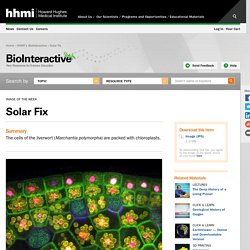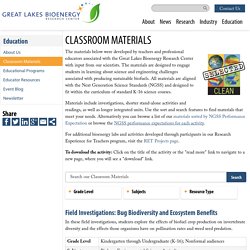

Hhmi. Chloroplasts (here colored yellow) are organelles in cells of plants and algae that capture energy from sunlight and convert it to chemical energy by photosynthesis.

We are dependent on photosynthesis because it is responsible for most of the world's primary productivity, and also because fossil fuels are mostly from remains of prehistoric plants. A typical plant cell contains about 10 to 100 chloroplasts. Chloroplasts are descended from early in evolutionary history when a eukaryotic cell incorporated photosynthetic cyanobacteria. Dead stuff: The secret ingredient in our food chain - John C. Moore. Carbon Time Units. CTIME About Us. Great Lakes Bioenergy Research Center. The materials below were developed by teachers and professional educators associated with the Great Lakes Bioenergy Research Center with input from our scientists.

The materials are designed to engage students in learning about science and engineering challenges associated with producing sustainable biofuels. All materials are aligned with the Next Generation Science Standards (NGSS) and designed to fit within the curriculum of standard K-16 science courses. Materials include investigations, shorter stand-alone activities and readings, as well as longer integrated units. Use the sort and search features to find materials that meet your needs. Alternatively you can browse a list of our materials sorted by NGSS Performance Expectation or browse the NGSS performance expectations for each activity. Learning Activities - GLOBE.gov.
Journey to Forever. EnvLit - Working Groups. Media.collegeboard.com/digitalServices/pdf/ap/bio-manual/Bio_Lab10-EnergyDynamics.pdf. Www.livingston.org/cms/lib4/NJ01000562/Centricity/Domain/781/Key for Energy Dynamics Lab 13.pdf. Ecology Quizzes. Quiz 10.3: Food Chains.